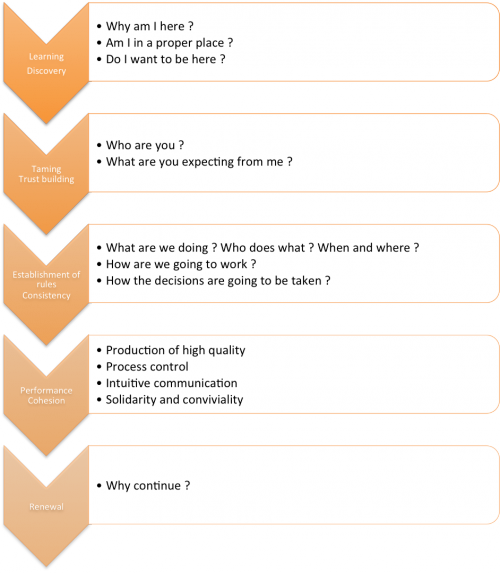 I often speak about collaboration or community management, but finally I realize that I have never discussed the various stages of development of a team working in a collaborative way. Maybe your teams are already working this way, but generally they have to cross various stages of maturity before succed to be a real community. Everything is a cycle, a process, which often begins again with the end of a project or changes within the team (hopefully you do not start all over again). If you are interested by that topic, just go and check the community maturity model of the community roundtable, a real work of art, more focus about community maturity inside the all organization.
I often speak about collaboration or community management, but finally I realize that I have never discussed the various stages of development of a team working in a collaborative way. Maybe your teams are already working this way, but generally they have to cross various stages of maturity before succed to be a real community. Everything is a cycle, a process, which often begins again with the end of a project or changes within the team (hopefully you do not start all over again). If you are interested by that topic, just go and check the community maturity model of the community roundtable, a real work of art, more focus about community maturity inside the all organization.
It goes generally through 4 stages: they can be more or less long, you can spare one of course, it remains a model with all that a model has of restrictive.
Stage 1: embryonic community
- The community is more potential than real
- Individualism and compartmentalization
- Sense of belonging, cooperation, shared responsibility are weak or non-existent
- The members of the group can work « indeed » individually but there is no team effet, in an operational point of view as much as a human one
- The nature of the organization is characterized by a one to one relationship with the manager / facilitator
Stage 2: potential community
- Â Human cohesion developed on an interpersonal mode
- The sense of belonging is real and affects the satisfaction of individuals, even if it does not still impact the « efficiency »
- This stage already presents the advantage of removing the main difficulties encountered in highly compartmentalized teams operating from individualistic practices and strong segmentation tasks
- This second stage constitutes the basis of the following by creating an environment that opens doors to cooperation
Many companies are at this stage or for a part at the next one
Stage 3: constituted community
- Â Establishment and acceptance of a community of objectives
- This is the first level of a real team in which each one perceives that operate collaboratively or as an entity does not exclude the individual dimension
- All members of the community fit their purpose whit those of the community and accept personal and operational interdependence
- Each one drives its operations in an ongoing relationship with the other, in a permanent effort of cohesion, coherence and sharing
- Employees present a strong identification with the stake to the objective, cohesion has become essential, the manager integrates the totality of the talents
Stage 4: Collective Intelligence and collaborative practices
- At the stage of collective intelligence operates a quite rare phenomenon which leads to a unity of understanding and reaction between the different members of the community. At this stage, the collaborative mode is inegrated for each
- Their habit of working together, the resulting success, the preliminary work, the confrontation of opinions, tactical scenarios developed together and the use of all the talents… in the end produce a quick, consistent and coherent reaction whatever the risks that arise
This collective intelligence allows unit reaction in all situations is precisely rooted in the diversity of the persons, diversity known by all and used by all.
Of course to reach this stage of collective functionning, each employee must also have an individual development and understanding of his role inside the team which follows the same way.

